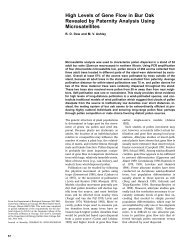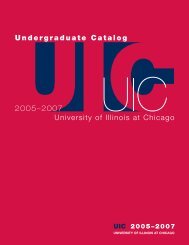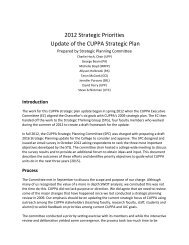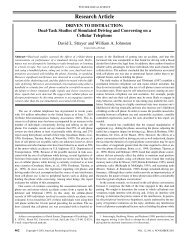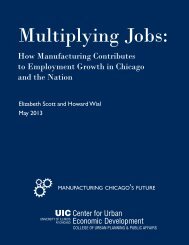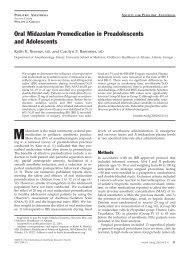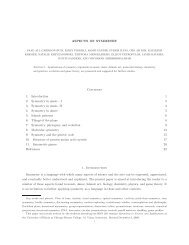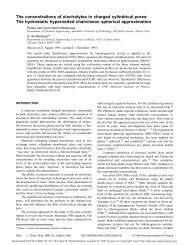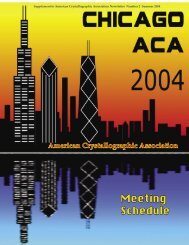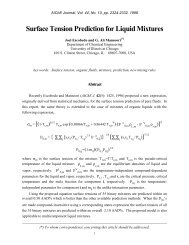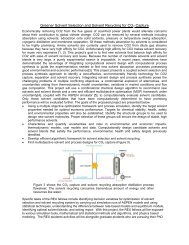Sustainable Transportation and Grounds in UIC - University of ...
Sustainable Transportation and Grounds in UIC - University of ...
Sustainable Transportation and Grounds in UIC - University of ...
Create successful ePaper yourself
Turn your PDF publications into a flip-book with our unique Google optimized e-Paper software.
Report to <strong>UIC</strong> Chancellor’s Committee on Susta<strong>in</strong>ability <strong>and</strong> Energy<br />
Table 2: Mode Choice by Percentage <strong>of</strong> Use for those us<strong>in</strong>g three modes<br />
First Mode<br />
Share<br />
%<strong>of</strong><br />
Use<br />
Second Mode<br />
Share<br />
%<strong>of</strong> Use Third Mode<br />
Share<br />
% <strong>of</strong><br />
Use<br />
Drive Alone 37% Metra 57% CTA or PACE 32%<br />
Bus<br />
Walk 22% “El” 20% Walk 30%<br />
CTA (or PACE) 13% CTA (or PACE) 12% “El” 24%<br />
Bus<br />
Bus<br />
Metra 11% Walk 4% Intercampus 8%<br />
Shuttle<br />
Carpool 8% Bike 2% Commuter 3%<br />
Shuttle<br />
Bike 6% Intercampus or 2% Bike 2%<br />
Commuter<br />
Shuttle<br />
“El” 4% Drive Alone 2% Metra 2%<br />
Schedules <strong>and</strong> Arrival Times<br />
Work schedules are an important component <strong>of</strong> travel dem<strong>and</strong>.<br />
Academic <strong>in</strong>stitutions are likely to have a greater percentage <strong>of</strong><br />
workers who are on variable schedules, compared to private<br />
bus<strong>in</strong>esses <strong>and</strong> government agencies, which are more likely to<br />
operate dur<strong>in</strong>g the usual “9 to 5” times.<br />
In <strong>UIC</strong>, staff <strong>and</strong> part-time students have the most predictable<br />
schedules. Faculty members tend to be on campus dur<strong>in</strong>g the<br />
bus<strong>in</strong>ess day with a somewhat varied schedule, while full-time<br />
students have the greatest schedule variety, with more than 25%<br />
stat<strong>in</strong>g that their schedules vary considerably.<br />
The distribution <strong>of</strong> rides made by U-PASS holders is given, by type <strong>of</strong><br />
day (weekday or weekend day) <strong>in</strong> Figure 6. For weekday rides, it can<br />
be seen that the peak time period is the midday period (9AM-3PM).<br />
Thus, student U-PASS holders do not have the typical travel pr<strong>of</strong>iles<br />
<strong>of</strong> commuters <strong>in</strong> general – for general commuters, there is a morn<strong>in</strong>g<br />
peak <strong>of</strong> transit rides (6AM-10AM) <strong>and</strong> an even<strong>in</strong>g peak (3PM-7PM).<br />
Look<strong>in</strong>g at the time distribution <strong>of</strong> trips over the weekend (which are <strong>in</strong><br />
all likelihood, discretionary or recreational trips), the peak hours for U-<br />
Pass trips are the midday time period (9AM to 3PM) <strong>and</strong> the even<strong>in</strong>g<br />
time period (6PM-9PM). One implication <strong>of</strong> this pattern is that the U-<br />
PASS program is help<strong>in</strong>g boost transit ridership dur<strong>in</strong>g time periods<br />
when it does not typically have high volumes <strong>of</strong> riders.<br />
15



